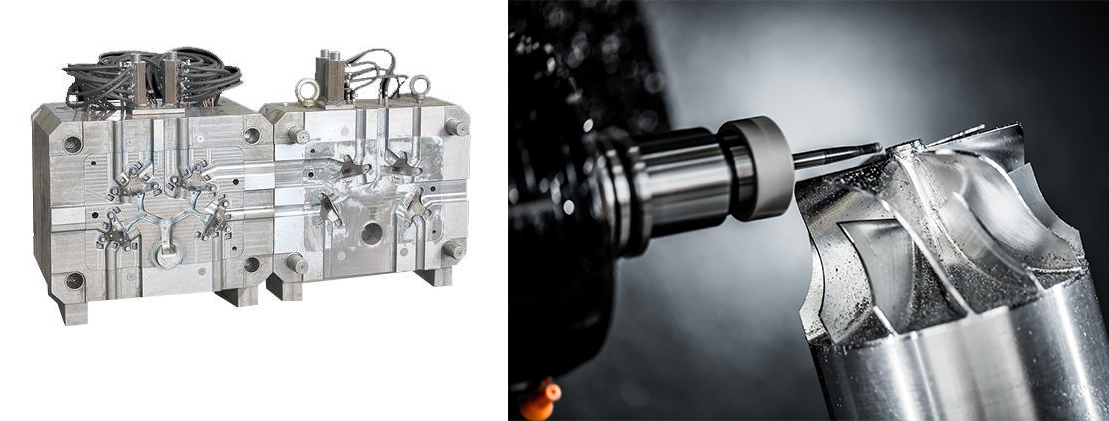คุณเคยสงสัยหรือไม่ว่ากระบวนการใดดีกว่าสำหรับโครงการ Die Casting Vs ของคุณ? เครื่องจักรกลซีเอ็นซี? ผู้คนมักจะสับสนเมื่อทั้งสองแนวทางมีประโยชน์มากมายที่ทำให้พวกเขาน่าดึงดูด การเลือกวิธีการที่ไม่ถูกต้องอาจทำให้เกิดความล่าช้า ต้นทุนสูงขึ้น และคุณภาพของผลิตภัณฑ์ไม่ดี หากคุณประสบปัญหาว่าวิธีใดในสองวิธีที่เหมาะกับคุณที่สุด ไม่ต้องกังวล เพราะคำแนะนำนี้จะขจัดความสับสนให้กับคุณ
ปัจจัยหลักที่กำหนดการตัดสินใจระหว่างการหล่อขึ้นรูปกับการตัดเฉือน CNC คือปริมาณการผลิต วัสดุ และความแม่นยำ แม้ว่าการหล่อแบบตายตัวจะเหมาะสมที่สุดสำหรับการใช้งานในปริมาณมาก ซึ่งชิ้นส่วนมีขนาดค่อนข้างใหญ่และมีรูปร่างที่ซับซ้อน การตัดเฉือน CNC เหมาะที่สุดสำหรับปริมาณน้อย รูปร่างที่ซับซ้อน และพิกัดความเผื่อที่เข้มงวดมากขึ้น มันจะช่วยคุณพิจารณาว่าวิธีใดที่เหมาะกับโครงการของคุณเมื่อคุณเรียนรู้ว่าโครงการของคุณต้องการอะไร
ตอนนี้ถึงเวลาที่จะขยายข้อมูลเกี่ยวกับแต่ละกระบวนการเหล่านี้ ในหัวข้อย่อยถัดไป จะมีการเปรียบเทียบระหว่างแม่พิมพ์หล่อกับเครื่องจักร CNC ในด้านต่างๆ เช่น ต้นทุน ความเร็ว และวัสดุที่มีอยู่

การหล่อแบบตายตัวเกี่ยวข้องกับการบังคับให้เทโลหะหลอมเหลวลงในแม่พิมพ์ ซึ่งเรียกอีกอย่างว่าแม่พิมพ์ แม่พิมพ์มักจะทำจากเหล็ก และใช้กระบวนการนี้เมื่อต้องการชิ้นส่วนที่มีรูปทรงที่ซับซ้อนและมีความคลาดเคลื่อนใกล้เคียง การหล่อแบบส่วนใหญ่จะใช้กับโลหะ เช่น อลูมิเนียม สังกะสี แมกนีเซียม และโลหะผสม เช่นเดียวกับทองแดง กระบวนการนี้ช่วยให้สามารถขึ้นรูปชิ้นส่วนโลหะที่ซับซ้อนและแม่นยำได้ในเวลาอันสั้น เหมาะสำหรับการผลิตจำนวนมาก
ในการหล่อแบบตายตัว โดยทั่วไปแม่พิมพ์จะทำจากวัสดุที่มีความแข็งแรงสูง โลหะที่มีรูปร่างตามต้องการจะถูกฉีดเข้าไปในโพรงแม่พิมพ์ด้วยความดันสูง ตรงไหนที่เย็นตัวและแข็งตัว หลังจากที่แม่พิมพ์เย็นลง ชิ้นส่วนจะถูกปล่อยออกจากแม่พิมพ์โดยการทำความสะอาดแบบตัดแต่งอย่างแม่นยำ หรือแม้แต่กระบวนการอื่นๆ
การหล่อแบบตายตัวมีชื่อเสียงในด้านระยะเวลาการทำงานที่สั้น การใช้แม่พิมพ์ทำให้ง่ายต่อการผลิตชิ้นส่วนในปริมาณมาก ซึ่งทำให้การผลิตรวดเร็วที่สุด รอบเวลาโดยรวมมีตั้งแต่ไม่กี่วินาทีไปจนถึงสองสามนาที ขึ้นอยู่กับรูปทรงของชิ้นส่วนและวัสดุที่ใช้
กระบวนการนี้มีราคาถูกเมื่อใช้ในการผลิตชิ้นส่วนหลายชิ้นในคราวเดียวหรือในกำลังการผลิตขนาดใหญ่ โดยรวมแล้วต้นทุนการหล่อแบบตายตัวยังต่ำกว่าต้นทุนกระบวนการอื่นๆ เนื่องจากต้นทุนต่อหน่วยลดลงตามปริมาณการผลิต เมื่อสร้างแม่พิมพ์แล้ว ชิ้นส่วนต่อๆ ไปจะถูกผลิตขึ้นโดยมีต้นทุนเพิ่มเติมต่อชิ้นที่ค่อนข้างต่ำ
นอกจากนี้ การหล่อขึ้นรูปยังสามารถผลิตชิ้นส่วนที่มีรูปทรงที่ซับซ้อนมากซึ่งไม่สามารถผลิตได้ง่ายโดยใช้วิธีการแบบเดิมๆ คุณสมบัติที่มีรายละเอียดและการออกแบบที่ซับซ้อนสามารถทำได้โดยมีความหนาบางที่สุดเท่าที่จะเป็นไปได้ ทำให้การหล่อแบบตายตัวเหมาะสมในอุตสาหกรรมต่างๆ เช่น อุตสาหกรรมรถยนต์ อุตสาหกรรมอิเล็กทรอนิกส์ และอุตสาหกรรมเครื่องบิน ซึ่งจำเป็นต้องมีคุณสมบัติดังกล่าวเป็นส่วนใหญ่
โดยปกติแล้วส่วนประกอบที่ทำผ่านการหล่อด้วยแม่พิมพ์จะมีผิวสำเร็จที่เรียบและมีพิกัดความเผื่อต่ำ ดังนั้นจึงจำเป็นต้องมีขั้นตอนหลังการประมวลผลเพียงเล็กน้อย ความแม่นยำและความละเอียดประณีตดังกล่าวมีประโยชน์ในหลายอุตสาหกรรมที่ผลิตภัณฑ์ขั้นสุดท้ายต้องได้รับการออกแบบตามมาตรฐานที่กำหนด หรือในกรณีที่ต้องเป็นไปตามมาตรฐานประสิทธิภาพที่กำหนด
ชิ้นส่วนหล่อเป็นหนึ่งในส่วนประกอบที่ได้รับความนิยมมากที่สุดเนื่องจากมีลักษณะทางกลที่ค่อนข้างสูง รวมถึงความแข็งแรงและความทนทาน แรงกดที่ใช้ในการหล่อจะช่วยเพิ่มความหนาแน่นของโครงสร้างจุลภาคของวัสดุ ทำให้ผลิตภัณฑ์ขั้นสุดท้ายมีความแข็งแรงและทนทานต่อการสึกหรอและการกัดกร่อนได้ดี
กระบวนการนี้เหมาะสำหรับวัสดุที่เลือกโดยเฉพาะเท่านั้น โดยทั่วไปวัสดุที่ไม่ใช่เหล็กมักนิยมใช้ซึ่งรวมถึงโลหะ เช่น อลูมิเนียม สังกะสี และแมกนีเซียม แม้ว่าวัสดุเหล่านี้จะได้รับความนิยมในอุตสาหกรรมต่างๆ แต่การหล่อขึ้นรูปก็มีข้อจำกัดอยู่บ้าง โดยเฉพาะกับโลหะที่มีอุณหภูมิหลอมเหลวสูง เช่น เหล็กหรือไทเทเนียม ข้อจำกัดนี้อาจกลายเป็นข้อเสียในบางการใช้งานที่จำเป็นต้องใช้วัสดุดังกล่าว
โดยพื้นฐานแล้ว แม่พิมพ์ (แม่พิมพ์) จะถูกสร้างขึ้น เนื่องจากชิ้นส่วนที่สลับซับซ้อนอาจมีราคาแพงในการพัฒนา โดยทั่วไปแม่พิมพ์จะขึ้นรูปด้วยเหล็กที่มีความแข็งแรงสูง จึงมีช่วงระยะสูงสำหรับการตั้งค่าเริ่มต้น นี่คือเหตุผลว่าทำไมการหล่อแบบตายตัวจึงมีราคาค่อนข้างแพงสำหรับการผลิตขนาดเล็ก เนื่องจากค่าใช้จ่ายเริ่มแรกนี้ แต่เมื่อเกี่ยวข้องกับขนาดการผลิต ต้นทุนต่อหน่วยของผลิตภัณฑ์จะลดลงและมีราคาไม่แพงสำหรับปริมาณมาก
โดยปกติแล้วการหล่อแบบตายตัวจะเกี่ยวข้องกับการผลิตส่วนประกอบที่มีความแม่นยำและมีคุณภาพที่ดี อย่างไรก็ตาม ความอดทนที่ดีนั้นทำได้ยาก หากพิกัดความเผื่อมีความแม่นยำอย่างยิ่ง อาจจำเป็นต้องดำเนินการเพิ่มเติมเพื่อทำให้ชิ้นงานสมบูรณ์แบบ ซึ่งสามารถเพิ่มต้นทุนและเวลาทั้งหมดในการผลิตผลิตภัณฑ์เหล่านี้ โดยเฉพาะชิ้นส่วนขนาดเล็กและซับซ้อน
แม้ว่ากระบวนการหล่อจะมีประสิทธิภาพสูง แต่ผลิตภัณฑ์ก็อาจมีปัญหา เช่น ความพรุนของชิ้นส่วนที่ขึ้นรูปได้ อาจเกิดขึ้นได้หากโลหะหลอมเหลวไม่สามารถปกคลุมโพรงแม่พิมพ์ได้เต็มที่ หรือหากมีการระบายอากาศไม่ดี ไม่เพียงพอ หรือดำเนินการไม่เพียงพอบนแม่พิมพ์ อย่างไรก็ตาม ปัญหานี้ไม่ได้มีความสำคัญมากนัก แต่จะส่งผลกระทบต่อประสิทธิภาพและมาตรฐานของผลิตภัณฑ์สำเร็จรูป โดยเฉพาะอย่างยิ่งในการใช้งานที่มีประสิทธิภาพสูง
การเปลี่ยนแปลงการออกแบบชิ้นส่วนบนแม่พิมพ์มักจะยุ่งยากและมีค่าใช้จ่ายสูงเมื่อแม่พิมพ์ได้รับการพัฒนาสำหรับการออกแบบนั้นโดยเฉพาะ เนื่องจากการก่อตัวของแม่พิมพ์หรือการแก้ไขแม่พิมพ์ที่มีอยู่อาจต้องใช้เวลาและเงิน การหล่อแบบตายตัวจึงมีความแข็งค่อนข้างมากเมื่อเทียบกับกระบวนการตัดเฉือน CNC ซึ่งสามารถปรับเปลี่ยนได้ง่ายในระหว่างกระบวนการผลิต
เครื่องจักรกลซีเอ็นซี (คอมพิวเตอร์ควบคุมเชิงตัวเลข) หมายถึงกระบวนการผลิตที่การเคลื่อนไหวของเครื่องมือได้รับคำสั่งจากโปรแกรมคอมพิวเตอร์ เนื่องจากมีความยืดหยุ่น จึงนิยมใช้ในการผลิตชิ้นส่วนที่ต้องการขนาดและรูปร่างเฉพาะ อุปกรณ์ที่ใช้ในการตัดเฉือน CNC เช่น โรงสี เครื่องกลึง เราท์เตอร์ และเครื่องบด ได้รับการควบคุมโดยโปรแกรมคอมพิวเตอร์เพื่อสร้างวัตถุดิบให้เป็นผลิตภัณฑ์ที่รวบรวม กระบวนการนี้สามารถรองรับวัสดุได้หลากหลาย เช่น โลหะ พลาสติก ไม้ และวัสดุผสม
เครื่อง CNC ทำงานโดยการควบคุมการเคลื่อนที่ของเครื่องมือตัดในหลายทิศทาง ซึ่งรวมถึงการเจาะ กัด หมุน หรือเจียรสาม สี่ หรือห้าทิศทาง การออกแบบชิ้นส่วนอยู่ในรูปแบบดิจิทัล โดยปกติแล้วไฟล์ CAD จะถูกอัปโหลดไปยังเครื่อง CNC ซึ่งจะถูกตีความโดยซอฟต์แวร์ CNC และการเคลื่อนไหวจะถูกสร้างและดำเนินการอย่างประณีต ระบบอัตโนมัติดังกล่าวรับประกันความถูกต้องและเป็นมาตรฐานของกระบวนการผลิตทั้งหมด
เครื่องจักร CNC สามารถทำงานด้วยความแม่นยำเพียงไม่กี่ไมครอน (หนึ่งในพันมิลลิเมตร) ดังนั้นจึงเหมาะสำหรับการใช้งานที่ไวต่อความแม่นยำ เช่น การบินและอวกาศ รถยนต์ และการใช้งานทางการแพทย์ ข้อดีอีกประการหนึ่งของการตัดเฉือน CNC ก็คือสามารถทำซ้ำได้หลายครั้งและยังคงผลลัพธ์ที่เกือบจะเหมือนกันเนื่องจากการควบคุมที่แม่นยำด้วยคอมพิวเตอร์
เครื่องจักรกลซีเอ็นซีสามารถจัดการกับวัสดุได้แทบทุกประเภท เนื่องจากมีความสามารถอย่างมากในเรื่องของวัสดุที่ใช้ ต่างจากการหล่อแบบที่มีข้อจำกัดด้านวัสดุที่สามารถใช้ได้ เครื่องจักร CNC สามารถรองรับวัสดุได้ทุกประเภท เช่น อลูมิเนียม เหล็ก ไทเทเนียม พลาสติก วัสดุคอมโพสิต และไม้ คุณสมบัตินี้ทำให้เหมาะสำหรับใช้ในอุตสาหกรรมต่างๆ ที่ต้องใช้ชิ้นส่วนที่ทำจากวัสดุที่แตกต่างกันซึ่งมีลักษณะทางกลและประสิทธิภาพต่างกัน
CNC ให้ความยืดหยุ่นสูง โดยเฉพาะอย่างยิ่งในกรณีที่มีการเปลี่ยนแปลงการออกแบบหรือการดัดแปลงผลิตภัณฑ์ ขึ้นอยู่กับการเขียนโปรแกรมซอฟต์แวร์ของเครื่อง CNC การปรับแต่งสามารถทำได้อย่างง่ายดายโดยไม่ต้องสั่งแม่พิมพ์หรือเครื่องมือใหม่ ด้วยเหตุนี้ การตัดเฉือน CNC จึงเหมาะอย่างยิ่งสำหรับการสร้างต้นแบบ การวิ่งระยะสั้น หรือการดำเนินการครั้งเดียว ซึ่งมักเกิดขึ้นกับผลิตภัณฑ์สั่งทำพิเศษ เหมาะสำหรับส่วนประกอบที่มีคุณสมบัติซับซ้อนหรือละเอียดอ่อนซึ่งอาจตัดเฉือนได้ยากหรือมีราคาแพงมากจากการหล่อแบบตายตัว
การตัดเฉือน CNC ให้ความสามารถในการออกแบบรูปทรงที่ซับซ้อน รวมถึงช่องแคบและส่วนที่ยื่นออกมาซึ่งอาจเป็นไปไม่ได้ที่จะนำไปใช้กับกระบวนการอื่นๆ เช่น การฉีดขึ้นรูปหรือการหล่อแบบตายตัว เนื่องจากการตั้งค่าการตัดเฉือน CNC ที่สมบูรณ์แบบ ผลิตภัณฑ์ขั้นสุดท้ายจึงสามารถบรรลุรูปทรงที่ซับซ้อนมาก คุณลักษณะต่างๆ เช่น เกลียว ทางเดินภายใน และรัศมีแคบได้อย่างแม่นยำในระดับมาก
เมื่อเปรียบเทียบกับการหล่อแบบตายตัวซึ่งต้องใช้แม่พิมพ์ราคาแพงสำหรับการผลิตชิ้นส่วนจำนวนมาก การตัดเฉือน CNC ไม่จำเป็นต้องใช้เครื่องมือราคาแพงสำหรับแต่ละชิ้นส่วน การลงทุนที่ใหญ่ที่สุดในการตัดเฉือน CNC คือเวลาที่เครื่องจักร CNC ใช้และค่าแรง แต่เมื่อสร้างโปรแกรม CNC ขึ้นมา ก็สามารถผลิตชิ้นส่วนได้ในเวลาไม่นานโดยมีค่าใช้จ่ายเพิ่มขึ้นเพียงเล็กน้อย ซึ่งช่วยให้การตัดเฉือน CNC มีราคาถูกลงสำหรับการผลิตในปริมาณน้อยถึงปานกลางหรือในกรณีที่มีการเปลี่ยนแปลงการออกแบบบ่อยครั้ง
เมื่อเปรียบเทียบการตัดเฉือน CNC กับการหล่อขึ้นรูป CNC จะมีราคาถูกกว่าสำหรับการผลิตในระดับต่ำถึงขนาดกลาง อย่างไรก็ตาม มันไม่คุ้มต้นทุนสำหรับการผลิตจำนวนมาก ต้นทุนต่อชิ้นส่วนในการตัดเฉือน CNC อาจค่อนข้างสูง เนื่องจากแต่ละชิ้นส่วนมีการตัดเฉือนที่แตกต่างกันและใช้เวลาทุ่มเทสูง ทำให้มีค่าใช้จ่ายสูงสำหรับการผลิตส่วนประกอบอย่างง่ายในปริมาณมากซึ่งสามารถผลิตได้โดยวิธีการหล่อแบบตายตัว
โดยทั่วไปแล้ว การหล่อแบบตายตัวจะเร็วกว่าการตัดเฉือน CNC ในแง่ที่ว่าแบบหลังจะเหมาะสมกว่าสำหรับการผลิตชิ้นส่วนจำนวนมาก เครื่องจักร CNC สามารถทำงานได้ตลอด 24 ชั่วโมงทุกวัน แต่กระบวนการถอดหรือสร้างวัสดุ ไม่ว่าจะผ่านการตัด เจาะ หรือการกัดแต่ละชิ้นส่วนได้รับการแก้ไขในทุกรอบ ทำให้ช้ากว่ารอบเวลาที่รวดเร็วของการหล่อด้วยแม่พิมพ์ เมื่อเปรียบเทียบกับการหล่อทราย การหล่อแบบตายตัวทำได้เร็วกว่ามาก โดยเฉพาะอย่างยิ่งสำหรับการผลิตปริมาณมากซึ่งมีปริมาณงานสูง
เหตุผลก็คือ การตัดเฉือน CNC เป็นกระบวนการตัดวัสดุจากบล็อกแข็ง (หรือที่เรียกว่า "การกัด" หรือ "การตัดออก") ซึ่งส่งผลให้สิ้นเปลืองวัสดุจำนวนมากโดยเฉพาะเมื่อผลิตรูปทรงที่ซับซ้อน โดยปกติวัตถุดิบจะอยู่ในรูปของเหล็กแท่งหรือบล็อกขนาดใหญ่ และบางส่วนจะถูกตัดออกในระหว่างกระบวนการ สิ่งนี้สามารถนำไปสู่สถานการณ์ที่เกิดต้นทุนวัสดุ โดยเฉพาะอย่างยิ่งเมื่อวัสดุมีราคาแพง เช่น ไทเทเนียมหรือโลหะผสมประสิทธิภาพสูง
แม้ว่าการตัดเฉือน CNC จะสามารถสร้างชิ้นส่วนที่มีความแม่นยำสูง แต่ขนาดของชิ้นส่วนอาจได้รับผลกระทบเนื่องจากความสามารถของเครื่องจักรที่จำกัด ส่วนประกอบบางส่วนมีขนาดใหญ่กว่า ซึ่งอาจรวมถึงการใช้เครื่องมือพิเศษหรือต้องแบ่งเป็นชิ้นส่วนเล็กๆ ในการกลึง ซึ่งต้องใช้เวลาและความพยายามเป็นพิเศษ ข้อจำกัดนี้หมายความว่าการตัดเฉือน CNC อาจไม่สะดวกสำหรับโครงการขนาดใหญ่/ขนาดใหญ่ หรือขนาดใหญ่/หนัก เท่ากับไม่สะดวกสำหรับวิธีการอื่นๆ
เครื่องมือทุกชิ้นที่ใช้ในการกลึง CNC จะเสื่อมสภาพตามกาลเวลา โดยเฉพาะอย่างยิ่งเมื่อตัดวัสดุแข็งหรือสร้างผลิตภัณฑ์เดียวกันหลายชิ้น การสึกหรอนี้อาจทำให้ความแม่นยำหรือคุณภาพของประสิทธิภาพของเครื่องมือลดลง ดังนั้นจึงจำเป็นต้องบำรุงรักษาหรือเปลี่ยนเครื่องมือ เมื่อพูดถึงชิ้นส่วนที่มีความแม่นยำสูง ความคมของเครื่องมือ และประสิทธิภาพอาจเป็นปัจจัยสำคัญสู่ความสำเร็จในการได้รับคุณภาพสูง
การหล่อโลหะ: อลูมิเนียม สังกะสี แมกนีเซียม และโลหะผสมทองแดงถูกนำมาใช้อย่างสูงในเทคนิคนี้ แต่ก็สามารถจัดการกับโลหะเหล็กได้เช่นกัน การเลือกใช้วัสดุยังมีข้อจำกัดมากกว่าการตัดเฉือน CNC แต่วัสดุนี้ให้ความแข็งแรงและมีน้ำหนักเบา
การตัดเฉือน CNC: การตัดเฉือน CNC มีความหลากหลายมากขึ้น สามารถใช้กับวัสดุได้หลากหลาย เช่น โลหะ เช่น อลูมิเนียม เหล็ก ไทเทเนียม พลาสติก วัสดุผสม และแม้แต่ไม้ ด้วยเหตุนี้ การตัดเฉือน CNC จึงสามารถนำไปใช้ในด้านต่างๆ และสำหรับการใช้งานเฉพาะด้านได้
Die Casting: ยั่งยืนสำหรับการผลิตปริมาณมาก หลังจากผลิตแม่พิมพ์แล้ว รอบเวลาจะลดลงประมาณไม่กี่วินาที และเหมาะอย่างยิ่งสำหรับการใช้งานที่มีอัตราการผลิตสูง ในปริมาณมาก กระบวนการนี้จะมีประสิทธิผลเป็นพิเศษและส่งมอบผลิตภัณฑ์ที่สม่ำเสมอในแง่ของปริมาณ ไม่ว่าจะเป็นในหลายพันหรือหลายล้านชิ้น
CNC Machining: ช้ากว่าการหล่อแบบตายตัวเล็กน้อย โดยเฉพาะอย่างยิ่งเมื่อพูดถึงการผลิตจำนวนมาก ทำเป็นรายบุคคลและขึ้นอยู่กับความซับซ้อนของชิ้นส่วนเหล่านั้น อาจใช้เวลาหลายนาทีถึงชั่วโมงต่อส่วน มีประสิทธิภาพมากที่สุดในการผลิตระดับต่ำถึงปานกลาง ซึ่งจำเป็นต้องใช้ผลิตภัณฑ์ในปริมาณมากแต่มีความหลากหลายและความสมบูรณ์แบบในระดับที่สูงมาก
Die Casting: ความแม่นยำนั้นเข้ากันได้ แต่สามารถให้ความถูกต้องและรายละเอียดได้เพียงระดับกลางเท่านั้น เมื่อเทียบกับการตัดเฉือน CNC เหมาะอย่างยิ่งสำหรับการใช้งานที่มีรูปร่างซับซ้อน แต่อาจไม่ให้ผิวสำเร็จเรียบเนียนเท่ากับการใช้งานบางอย่าง
การตัดเฉือน CNC: ให้ความแม่นยำและความละเอียดที่ดีกว่าสำหรับชิ้นงาน และสามารถจับยึดขนาด/ขนาดที่เล็กมาก และคุณสมบัติที่ละเอียดได้ CNC ทำงานได้ดีที่สุดเมื่อมีความต้องการความแม่นยำ เช่น ในอวกาศหรือชิ้นส่วนทางการแพทย์อื่นๆ ที่รายละเอียดและความแม่นยำเป็นสิ่งสำคัญที่สุด
การหล่อแบบตายตัว: กระบวนการนี้มีราคาแพงในช่วงเริ่มต้นเนื่องจากต้นทุนแม่พิมพ์สูง แต่อัตราต่อชิ้นส่วนค่อนข้างต่ำเมื่อมีการผลิตชิ้นส่วนจำนวนมาก เหมาะที่สุดสำหรับการผลิตขนาดใหญ่เมื่อมีการกระจายต้นทุนไปยังผลิตภัณฑ์จำนวนมาก
การตัดเฉือน CNC: ไม่มีค่าใช้จ่ายด้านแม่พิมพ์ แต่ต้นทุนต่อชิ้นส่วนมักจะสูงกว่า เนื่องจากรอบเวลาที่ยาวนานขึ้น โดยเฉพาะสำหรับการกลึงขนาดใหญ่ ข้อดีของเทคนิคนี้คือ ราคาถูกกว่าสำหรับการผลิตปริมาณน้อยถึงปานกลาง และสำหรับการผลิตชิ้นส่วนเฉพาะทางหรือต้นแบบ แต่จะแพงเล็กน้อยสำหรับการผลิตปริมาณมาก (เปลี่ยนคำบางคำที่นี่ด้วย)
● ปริมาณการผลิต: ในกรณีที่ความต้องการการผลิตสูง การหล่อแบบตายตัวจะมีราคาถูกกว่า ในขณะที่การตัดเฉือน CNC เหมาะสำหรับการผลิตในระดับปานกลางมากกว่า
● ข้อกำหนดด้านวัสดุ: การตัดเฉือน CNC มีความหลากหลายในแง่ของการใช้วัสดุ ในขณะที่การหล่อแบบตายตัวได้รับการแก้ไขด้วยโลหะผสมบางชนิด
● ความต้องการที่แม่นยำ: เครื่องจักรกลซีเอ็นซีใช้สำหรับการใช้งานที่ต้องการความแม่นยำสูงและมีรายละเอียดที่ละเอียด ในขณะที่การหล่อแบบตายตัวนั้นเป็นที่นิยมสำหรับความคลาดเคลื่อนที่ง่ายกว่าในการผลิตในปริมาณมากโดยใช้วัสดุที่หลากหลายต่ำมาก
● การผลิตจำนวนมาก: เมื่อเราต้องการการผลิตชิ้นส่วนต่างๆ จำนวนมากที่มีรูปร่างซับซ้อนในระยะเวลาอันสั้นและด้วยต้นทุนที่สมเหตุสมผล การหล่อแบบตายตัวมีความเหมาะสมที่สุดในการผลิตในปริมาณมาก โดยมีการประเมินต้นทุนต่อชิ้นส่วน
● รูปทรงที่ซับซ้อน: ยังมีประโยชน์สำหรับการผลิตชิ้นส่วนที่มีรูปทรงและรายละเอียดที่ซับซ้อนในอัตราที่รวดเร็ว โดยเฉพาะอย่างยิ่งสำหรับการผลิตปริมาณมากอย่างมีประสิทธิภาพและมีคุณภาพ
● การทำงานแบบกำหนดเองหรือน้อย: การตัดเฉือน CNC เหมาะสำหรับความต้องการในการผลิตน้อยถึงปานกลาง โดยผลิตตัวอย่างเพียงไม่กี่ตัวอย่าง หรือในกรณีที่มีการเปลี่ยนแปลงการออกแบบบ่อยครั้ง
● ชิ้นส่วนที่มีความแม่นยำสูง: เมื่อมีรายละเอียดปลีกย่อยที่ต้องเพิ่มภายในแม่พิมพ์ หรือมีเส้นเฉพาะที่ต้องเพิ่มด้านนอกของแม่พิมพ์ หรือรูปทรงบางอย่างที่ไม่สามารถสร้างในการหล่อแบบไดคาสติ้งได้เนื่องจาก ของระดับความแม่นยำที่ต้องการ
การหล่อขึ้นรูปและการตัดเฉือน CNC เป็นกระบวนการสองกระบวนการที่แตกต่างกันค่อนข้างมาก ซึ่งทั้งสองกระบวนการต่างก็มีข้อดีต่างกันไป การหล่อขึ้นรูปเหมาะที่สุดสำหรับปริมาณการผลิตที่สูง เครื่องมือราคาไม่แพง และการออกแบบที่ซับซ้อน และในขณะเดียวกัน การตัดเฉือน CNC ก็เหมาะสำหรับการผลิตระดับต่ำถึงปานกลาง การออกแบบที่ซับซ้อน ชิ้นส่วนที่มีพิกัดความเผื่อสูง และความแม่นยำ
● สำหรับการผลิตจำนวนมากและมีการออกแบบที่ซับซ้อน: เลือกการหล่อแบบตายตัว
● สำหรับการดำเนินการผลิตขนาดเล็กถึงขนาดกลาง ชิ้นส่วนสั่งทำพิเศษ หรือความต้องการความแม่นยำสูง: เลือกใช้เครื่องจักร CNC
โดยรวมแล้ว; จำเป็นต้องกำหนดข้อกำหนดของโครงการของคุณ รวมถึงกำลังการผลิต วัสดุ และความทนทาน ขั้นตอนสำคัญคือการสื่อสารกับผู้ผลิตหรือขอใบเสนอราคาเพื่อดำเนินการต่อ การเลือกกระบวนการที่เหมาะสมจะรับประกันความเป็นเลิศในการผลิตและความสามารถในการจ่ายของโครงการ